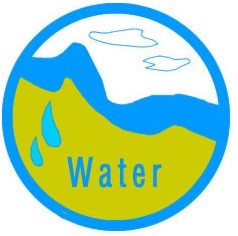1. 裂隙水优势流及其多尺度模拟
Multiscale fractures integrated equivalent porous media method for simulating flow and solute transport in fracture-matrix system:
The fracture–matrix system, in which water is stored and transported, has a significant impact on the hydraulic behaviors of fractured geologic media (FGM). However, it is very challenging to accurately simulate flow behavior in FGM due to the difficulty of characterizing dual-permeability media, including multiscale fractures with high permeability and porous matrix with low permeability. We proposed a multiscale fracture integrated equivalent porous medium (MFEPM) method for simulating fluid flow and solute transport in a fracture–matrix system. The MFEPM method has a high computational accuracy and good reliability, while maintaining an appropriate computational burden.
2. 多源信息融合的含水介质模拟
(1) Hydrofacies simulation based on transition probability geostatistics using electrical resistivity tomography and borehole data:
Hydrofacies distribution and heterogeneity influence groundwater flow and solute transport. The characterization of hydrofacies distribution is challenging because of the scarcity of observation data, and because of the various types of uncertainties in whatever observation data exist and in the geostatistical methods used. We presented a method to integrate geophysical data (ERT data) and borehole data to improve the characterization of hydrofacies distribution and to reduce uncertainty in the simulations of porous media, in particular, unconsolidated sedimentary clay/sand environments in unsaturated states. The results show that the ERT data, as a kind of high-density soft data, can provide more lithological information for TPG simulation. The presented method with transition probability geostatistics (TPG) can construct a relatively high-accuracy hydrofacies model by the combined use of ERT geophysical data and borehole data.
(2) Upscaling equivalent hydrofacies simulation based on borehole data generalization and transition probability geostatistics:
The heterogeneity of hydrofacies is represented as spatial variability on different scales, and it has a significant impact on the behaviors of groundwater flow and pollutant transport. However, effectively characterizing hydrofacies heterogeneity on different scales remains one of the most challenging problems in hydrogeology. We proposed an upscaling hydrofacies simulation (UHS) framework by integrating the upscaling borehole generalization (UBG) approach and the transition probability geostatistics (TPG). The results show that the UBG approach can significantly reduce borehole data volumes while retaining the key equivalent hydrofacies information on a coarser scale. The UHS method can well characterize the overall distribution of equivalent hydrofacies on coarser scales, with the minor-component hydrofacies underestimated and the major-component hydrofacies overestimated to a lesser extent, and more equivalent facies appear in strong heterogeneous areas. These results demonstrate that the UHS method can provide valuable capacity insights and advantages in characterizing hydrofacies heterogeneity on different scales using such high-density borehole lithological data.

3. 水土污染运移与修复模拟预测
Sensitivity analysis of factors influencing pollutant removal from shallow groundwater by the PRB method based on numerical simulation:
Permeable reactive barriers (PRB) is one of the most promising in-situ treatment methods for shallow groundwater pollution. However, optimal design of PRB is very difficult due to a lack of comprehensive understanding of various complex influencing factors of PRB remediation. In this study, eight of the main factors of PRB, including hydraulic gradient I, permeability coefficient KPRB of PRB material, PRB length L, PRB width W, PRB distance from pollution source Dist., the ratio of the maximum adsorption capacity to Langmuir constant of PRB material Qmax/KL, the discharge rate of pollution source DR and recharge concentration RC were investigated, to carry out the sensitivity analysis of PRB removal efficiency.

4. 矿井水文地球化学与水害防治
Hydrogeochemical characteristics analysis of multiple aquifers in coal mine based on nonlinear PCA and GIS:
Hydrogeochemical characteristic analysis of multiple categorical aquifers, including the delineation of hydrogeochemical spatial distributions, can provide a basic understanding of the groundwater flow system necessary for the prevention and control of groundwater damage associated with coal mines. Non-linear principal component analysis (PCA) was used to analyse the groundwater chemical characteristics of water samples from five aquifers in Gubei Coal Mine, Anhui Province, China. The relationships between water samples, variables, and water samples with variables were simultaneously analysed by the non-linear PCA. The findings demonstrate that combining non-linear PCA with GIS can be a powerful approach for conducting spatial non-linear analysis of hydrogeochemical characteristics.
